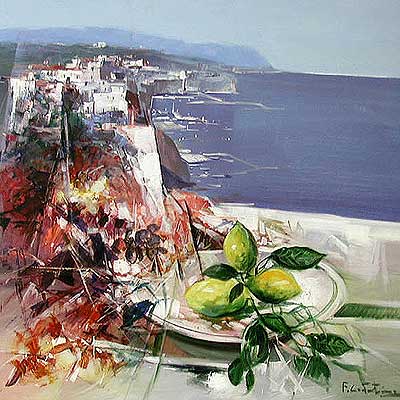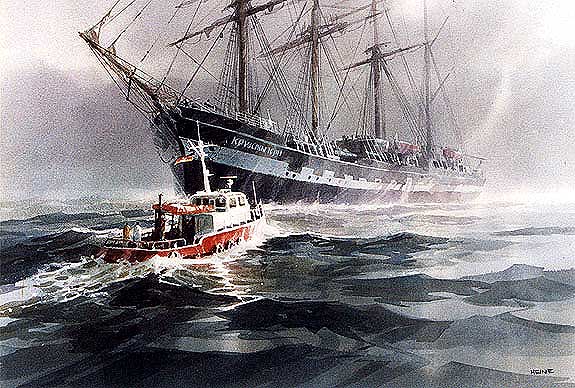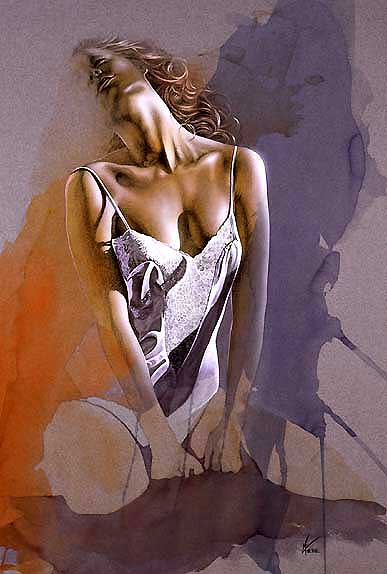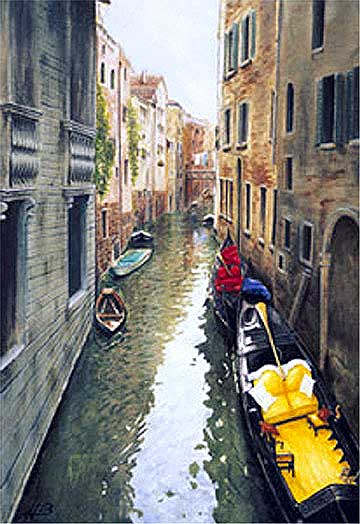Dear Artist,
All through his demonstration Harry Heine keeps saying things like, “This might not work out,” and “I’m not sure about this.” At the same time you have the idea that he knows exactly what he’s doing. Harry’s a watercolourist, famous for his marine subjects. His knowledge of boats is legendary. He’s been at it all his life. He puddles it on with a great big brush. He slants his paper so gravity is his helper. He thinks ahead for the big picture. He tips in minor gradations. He blots, wipes, sponges, scrapes, friskets and erases. Seemingly inconsequential touches focus his forms. The romance of shipping and sailing materializes from the fog of white paper. “This guy’s a maestro,” whispers somebody. “He’s a virtuoso,” says another.
It’s all over in about an hour. Harry puts his half-sheet into a mat and stands it up under a light. Everybody applauds. Marilyn Henderson announces that the coffee’s on. Artists surge toward Harry. They look closely at his brushes, his paint box, his old-fashioned ceramic palette. They check his favorite and particular colours; raw sienna, burnt sienna, alizarin crimson, Prussian blue (he used to like Winsor blue, “but the formula changed.”) These artists are looking for secrets, moxie, magic. They want to know if Harry’s virtuosity is in his box. And it is — partly. The rest is in all of the tens of thousands of mistakes Harry’s made over the years. He’s smart enough to know that he can still make them. “That ought to be toned down,” says Harry. A number of eyes follow his finger. “It could have been a lot better,” he says.
If you happen to be an artist who admires virtuosity, you’ve probably also pondered the mystery of what it takes to have it. The Oxford Dictionary defines a virtuoso as a skilled person with specialized knowledge. Skill and knowledge — add practice and time and you’ve got it. Virtuosity doesn’t mean flash and dazzle — it means workmanlike competence. At the finish line it may appear flashy, but the course isn’t. And no matter what the game — poker, pool, piano, or painting in watercolour, it’s the virtuoso that gets the applause.
Best regards,
Robert
PS: “There is virtue in virtuosity, especially today, when it protects us from the tedious spectacle of ineptitude.” (Robert Hughes)
Esoterica: Once seen and understood, virtuosity is irresistible and contagious. Harry and his wife Tess, a former carpet designer, produced three creative kids. Son Mark is a well-known illustrator and graphic designer; daughter Caren is a popular watercolourist; daughter Jennifer is an art director. “All in the family.”
Harry Heine
Heine Offspring Art
Humility
by Harley Colt, Houston, Texas, USA
Harry Heine’s humility is encouraging. I feel the same way while painting my best paintings, feverishly adding here and there, wondering if my hand knows what it is doing and then critiquing the finished work with the same words: “It could have been better.” I too see that there is further to go and that I too can get there. I am inspired after reading this piece — inspired by my own perceived inadequacies.
Generosity
by Linda Anderson, Hedley, BC, Canada
Harry Heine was my primary watercolor teacher and yes, he and his daughter Caren have held many workshops which I attended. His generosity in sharing all of his techniques and experiments in art is hard to match. When I asked him if he would talk to our little art group he and Caren came out with lots of information and slides. They traveled to us for the large budget sum of $75. I have one of his original demos — signed and given to me: all because I handed him a piece of watercolor paper to demo on. Thanks to generosity of artists such as Harry Heine, we become better artists.
Sign of the real
by Sophie Marnez, Lyon, France
Have you noticed that the fewer colors, brushes and gimmicks they use, the more of a virtuoso they are? To me this is also the sign of a real one: it is all in him, with little or no help from “artificial” tools. And it is probably why they cannot be plainly “imitated,” because tools do not provide talent! You have to have worked hard to reach it. Fair enough! Nothing comes out of the blue, especially virtuosity.
Performance art
by Anonymous, UK
Many of us terrific demonstration givers are adept at a creative presentation, subtle stage presence, audience manipulation, and have the gift of glib understatement whilst giving entertainment values. Amateurs like to be entertained at the same time as opening themselves to a little learning and growth. Curiously, it’s been my experience that these performances hone the skills and techniques of the demo-givers as well as the receivers. I wouldn’t be the artist I am today if it wasn’t for going through this sort of fun and games.
The dynamics of the demo
by Sheila Parsons, Conway, AK, USA
During my watercolor workshop demos I too have thousands of mistakes that have “slipped off my brush.” I can usually pull one off now with a fair amount of credibility. I too “talk” while painting and try not to abuse myself during the process. I have found that the “artist in me” responds much better to “Hey, that’s a lovely spot”, “Well, that worked,” “This could be the best watercolor I have ever done” better than the voice in me that keeps clammering “What do you think you are doing standing up here showing These Painters anything,” “Ugg, that is ugly,” “You call yourself an artist?” etc. I do talk about the problem areas as they develop but with the attitude of “Hey, there’s another challenge to my creative self.”It has taken a very conscious effort on my part to change that voice in my head from a nag to a supportive friend. I blossom like a cheerleader and the result is virtuosity!When my students complain that I make it look easy I usually quip: “It’s all done with mirrors” and gesture to the mirror above my head. I think the most important thing I have to teach anyone is to support their own efforts, brag on the good spots and forgive the goof-ups, knowing that they are essential in the process of attaining virtuosity.
Fashion influence
by Theresa Bayer, Austin, TX, USA
The painting Lingerie by Mark Heine brings to mind the influence of fashion photography on art. Fashion/ glamour photography has been around now for many decades and has a profound influence on our world. Some artists shy completely away from this influence, while others embrace it.
Zoltan Szabo
by Willa McNeill, Matthews, NC, USA
Many artists will know that the well-known artist and instructor Zoltan Szabo died in May of 2003. As a result, I inherited his small Harry Heine painting. It hangs where I see it daily. It is done with, as you say, virtuosity. It is a small piece of magic that Zoltan enjoyed so much. He was really proud to have it in his collection, as I am now.
George A. Rada
by Jacqueline Rada, New York, USA
My husband, George A. Rada, a realist painter in the finest tradition, passed away on December 8th, 2003. He was the embodiment of virtuoso painting. George was totally committed to being a realist painter throughout his life. His work defined virtuosity because he did not rush to complete hundreds of canvases in a specific time period nor did he resort to tricks or shortcuts or market demand. Each painting was where he wanted to be and it had his undivided attention until he thought it was completed to the highest level of his ability. That could be a month or a year. He had a complete understanding of color and painting technique which he applied to each of his works with love and excitement. His joy was always evident both in himself and in his work. How did he become a virtuoso? Discipline, hard work and of course lots of innate talent.
Hazel Harvey
by Jane Champagne, Southampton, ON, Canada
Hazel Harvey, my friend and former painting buddy, died December 20, 2003. She was an artist because she possessed the “art spirit”, the soul of an artist, that burning, almost obsessive energy that drives one to paint and paint and paint. She only let up when her vision and arthritis overtook her. I have never known anyone to be so completely consumed by the passion to paint.We painted together on location; she took the picture on the back of my book; we shared the best painting spots, coffee, discoveries, giggled over mishaps, got each other out of ditches. She wasn’t afraid of snarling dogs, I was, so she dealt with them; we shared the elation that comes from painting high on a hill overlooking a glowing valley in autumn, the sheer audacity of painting from a snowdrift in winter, the lazy approach in summer, and spring’s everlasting rebirth. When I broke my painting arm, she drove four hours to chauffeur me around while I taught outdoor painting. And, despite her shyness, did her first and last-ever demo.
Death of virtuosity
by Anonymous
The Harry Heines of this world will soon be obsolete because new technologies make it possible for almost anyone to make creditable watercolours using computer graphic systems. Further, with the advent of cheap Giclee print technology these images will find a wide world of acceptance. Your ideas of “the democratization of art” are happening before our very eyes, and the old fashioned guy who can do it in front of us will soon be history.
Bypassing the artist
by Janet Badger, Sulphur, CA, USA
With my computer and scanner, I have discovered that it is possible to completely bypass the Artist… leave myself out of the loop, so to speak! I could, if I wanted to, slap that inspiring photo on my scanner, play with it in Adobe, conjure up a creative image, and cough it out of my printer, Voila! I actually did bypass myself one time for an art project, going straight from photo to enlargement via scan, to the linoleum print. But there were problems in the creation of the plate that I realized came from the fact that I had not taken the time to learn the image through drawing. So, since then, I do that detailed drawing, I look carefully at the image, sketch it as best I can. I may go back to the photo to correct proportions, but when I step up to the plate, the image is in my mind and hand and that knowledge helps guide my hand.
Formatting problems
by M. Kelsey Webb
This morning I was looking at a recently finished painting, and I realized that it probably could have been as much as 50% larger. There were a couple of areas that were too fiddly for even a two-haired brush to deal with. And there were another couple of areas where I had used photo-transfer images of TV screens, where increased size would have made this more obvious by showing the scanning lines more clearly. I’m very meticulous (perhaps anal-retentive) as far as the planning of my pictures. But I do like to leave certain things up to chance. To me that’s where the fun and the art comes in. And I guess that I’ve been relying on sort of a sixth sense for my formatting. The problem with a very well thought out and slow working style is that you’re very loath to start all over again when you’re three-quarters finished with your painting. Aside from making more mistakes and benefiting by the experience, do you have any hints as to how I can avoid this problem in the future?
(RG note) Format and scale are the source of a great many problems. Think it out a bit before you start. Ask questions like, “Can I get my brush around those bottles? What sort of size will be the most powerful for this subject? Would squarer be better? “Try them out in your mind’s eye. It seems I’m always suggesting that artists work either smaller or larger. That’s ’cause I can’t often make up my mind myself. A lot of it has to do with what I call “metabolism.” How much of a lump can I digest today?
Classroom sparks
by Susan Park, Fennville, MI, USA
I was so moved by my first Twice-Weekly letter from you that I copied it and carried it in to read to my High School Art students the next day. Just the day before, I had been involved in a somewhat heated declaration concerning my feelings about “the wasting of precious time” during their brief 55-minute daily visit with me. The reply from one of them was like poison to my ears: “But we’re just not feeling inspired today.” Your letter gave me the impetus to go back and re-open that discussion once again, and we revisited the whole “Inspiration/ Perspiration” thing. Today, they actually worked harder! Thanks for your timely words. (I really appreciated the backup, as the classroom can sometimes be a very lonely place for an artist!)

Landscape with Still Life painting by Constantino |
You may be interested to know that artists from every state in the USA, every province in Canada, and at least 115 countries worldwide have visited these pages since January 1, 2003.
That includes Ann Hartley who wrote, “You could have been writing about Ed Whitney — remember him? I took several workshops with him — he was a master at doing demos.”
Other painters who were mentioned that we could be talking about were Rex Brandt, Millard Sheets, Don Getz, Judy Betts and Milford Zornes.




















